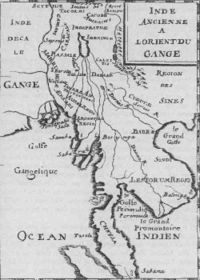Mekong
2007 Schools Wikipedia Selection. Related subjects: Geography of Asia
The Mekong is one of the world's major rivers. It is the 13th-longest in the world, and the 10th-largest by volume (discharging 475 km³ of water annually). Its estimated length is 4,023 km. It drains an area of 795,000 km²: From Tibet it runs through China's Yunnan province, Myanmar, Thailand, Laos, Cambodia and Vietnam. All except China and Myanmar belong to the Mekong River Commission. The extreme seasonal variations in flow and the presence of rapids and waterfalls have made navigation extremely difficult.
History
The difficulty of navigating the river has meant that it has divided, rather than united, the people who live near it. The earliest known settlements date to 2100 BCE, with Ban Chiang being an excellent example of that early Iron age culture. The earliest recorded civilisation was the 1st century Indianised-Khmer culture of Funan, in the Mekong Delta. Excavations at Oc Eo, near modern An Giang, have found coins from as far away as the Roman Empire. This was succeeded by the Khmer culture Chenla state by around the 5th century. The Khmer empire of Angkor was the last great Indianized state in the region. From around the time of the fall of the Khmer empire, the Mekong was the frontline between the emergent states of Siam and Tonkin (North Vietnam), with Laos and Cambodia, then situated on the coast, torn between their influence.
The first European to encounter the Mekong was the Portuguese Antonio de Faria in 1540; a European map of 1563 depicts the river, although even by then little was known of the river upstream of the delta. European interest was sporadic: the Spaniards and Portuguese mounted some missionary and trade expeditions, while the Dutch Gerrit van Wuysthoff led an expedition up the river as far as Vientiane in 1641-42.
The French took a serious interest in the region in the mid-19th century, capturing Saigon, from Vietnamese invaders, in 1861, and establishing a protectorate over Cambodia in 1863.
The first systematic exploration began with the French Mekong Expedition led by Ernest Doudard de Lagrée and Francis Garnier, which ascended the river from its mouth to Yunnan between 1866 to 1868. Their chief finding was that the Mekong had too many falls and rapids to ever be useful for navigation. The river's source was located by Pyotr Kuzmich Kozlov in 1900.
From 1893, the French extended their control of the river into Laos, establishing French Indochina by the first decade of the 20th century. This lasted until the First and Second Indochina Wars ended French and American involvement in the region.
After the Vietnam War, the tensions between the U.S.-backed Thai government and the new Communist governments in the other countries prevented cooperation on use of the river.
Phenomena
Balls of light are observable from time to time rising from the water's surface in the stretch of the river near Vientiane or Nong Khai. These are sometimes referred to as Naga fireballs. The locals attribute the phenomenon to Phaya Naga, Mekong Dragons.
According to researchers the river houses more species of giant fish than any world river , most notably the Giant Mekong Catfish.
The low tide level of the river in Cambodia is lower than the high tide level out at sea, and the flow of the Mekong inverts with the tides throughout its stretch in Vietnam and up to Phnom Penh. The very flat Mekong Delta area in Vietnam is thus prone to flooding, especially in the provinces of An Giang and Dong Thap (Đồng Tháp), near the Cambodian border.
A Mekong is also a type of alcoholic drink.


